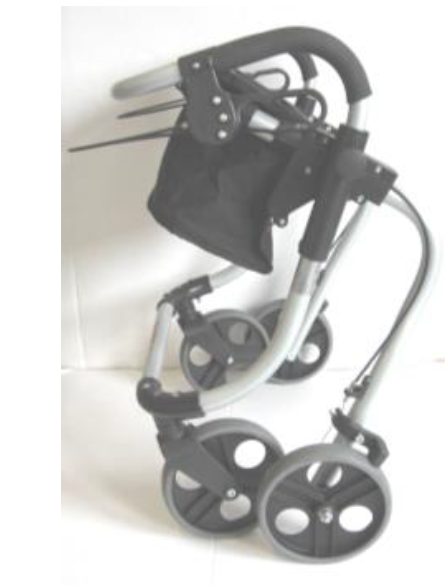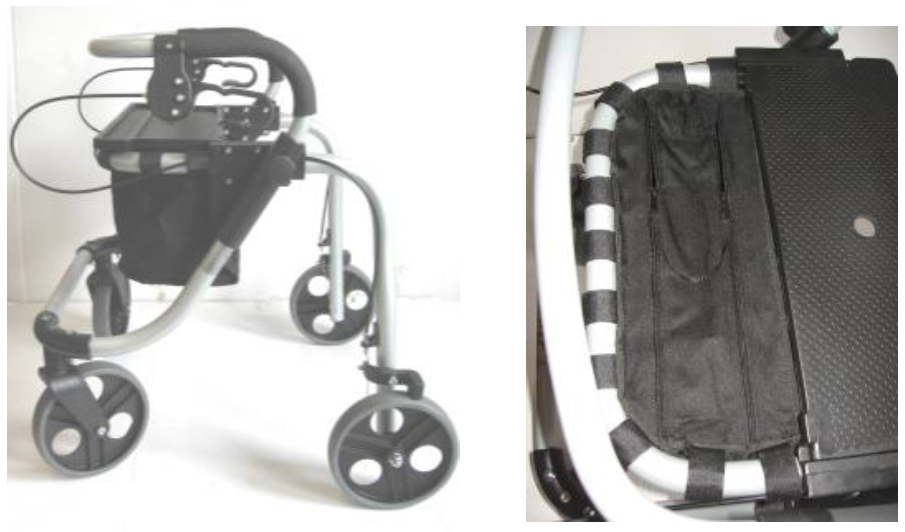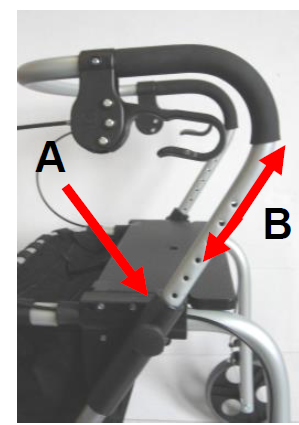REBOTEC Rollator Polo-Plus-T
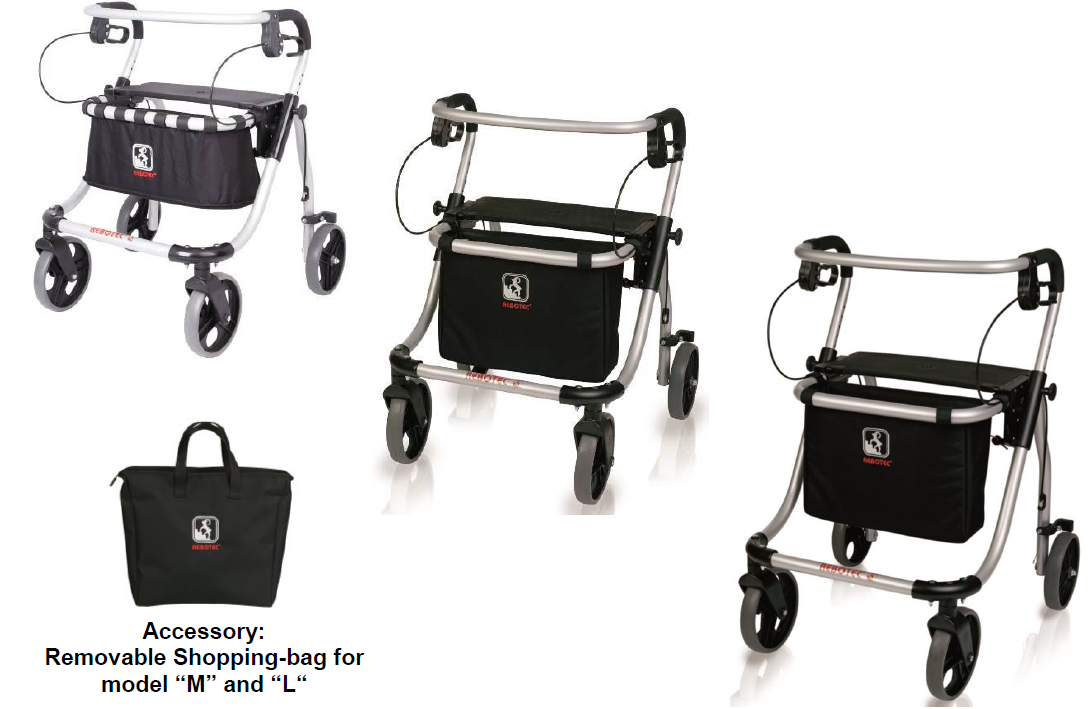
Important advisories!
- Read this User Instructions before first-time use of the Rollator and keep it ready for the user.
- Adhere to all advisories, especially the safety advisories.
- Keep this User Instructions booklet at hand for future use and subsequent sales.
- The user instructions and the maintenance manual are downloadable on our homepage.
Product Description
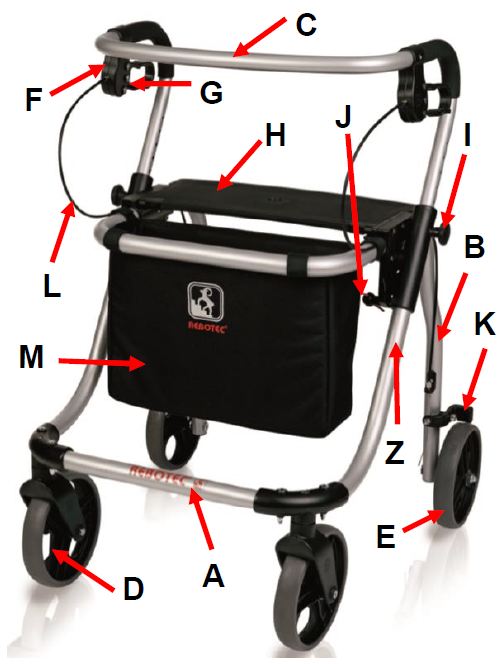
Rollator diagram shows:
| A | Front wheel bow |
| B | Rear wheel bow |
| C | Grip frame / handgrip |
| D | Front wheel compl. / swivel castor |
| E | Rear wheel / brake wheel |
| F | Hand lever |
| G | Brake handle |
| H | Plastic seat, foldable |
| I | Star grip for adjusting handle height |
| J | red pull-cord |
| K | Brake lever with brake pad |
| L | Cable for brake |
| M | Bag attached with Velcro |
| Z | Nameplate for product |
Nameplate (Z) – Example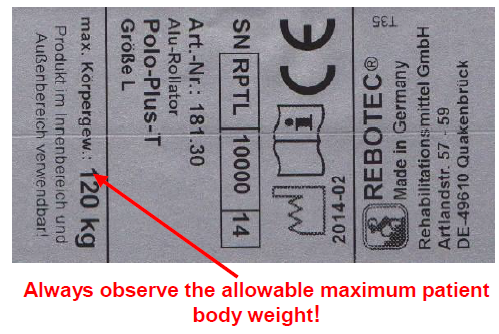 The name-plate is very important for product identification, and thus must not be removed..
The name-plate is very important for product identification, and thus must not be removed..
General advisories
Introduction
In this User Instructions booklet, you will find information and advisories for set-up, use, operation, maintenance and care of the Rollator Polo-Plus-T.
Intended proper use
The Rollator is an aid for patient mobility and is to be used by patients who have limited balance capability and considerably impaired ability to walk.The grip bow is height-adjustable to match the user’s size.The Rollator must not be used by patients who have disorders with perception, extremely limited balance capability, loss of or limited use of joints in both arms and who have difficulties sitting down.The Rollator can be used inside and outside and may be used only on solid, even surfaces. Never transport heavy objects with the Rollator.
Equipment advisories
The Rollator consists of a powder-paint coated frame and a height-adjustable grip bow. The 4 wheels consist of four tyres and plain bearings. The front wheels may be swivelled 360 degrees and the rear wheels are fixed.
A plastic seat serves for sitting (resting) and can be folded as a tablet. Hand brake levers with braking function are mounted on the grip handle on both the right and left sides. By activating the brake lever, the permanent locking or rolling brake can be activated.
The grip bow is completely rubber-coated in the area of the hand-grips. The Rollator is foldable for allowing easy transport. A pouch is attached to the frame. At the front of the frame is a removable bag attached with Velcro.
Warranty
There is a 2-year warranty on our Polo-Plus-T Rollator. A prerequisite for the warranty is use in accordance to the requirements outlined herein, as well as conducting regular maintenance. Excluded are all wear parts (e.g.: brake pads, brake cable, wheel, hand lever, seat board, bag).Not observing the User Instructions, improper maintenance and unauthorised modifications done to the product without the manufacturer’s permission automatically lead to the immediate nullification of warranty and product liability (see Maintenance).
The delivery date written on the REBOTEC delivery note applies as the valid start date of the warranty period.
Spare parts orders, complaints
To exclude incorrect spare parts deliveries and to ensure rapid processing of complaints, always provide the product name, serial number (SN) and the product’s year of manufacture. You can find this information on the Rollator’s nameplate or on the front cover of this User Instructions booklet.
Re-use, lifetime
The re-use (lifetime) depends on the product’s condition. Before re-use, maintenance of the Rollator must be conducted and the applicable instructions concerning safety care and maintenance must be fully adhered to.The expected lifetime of the Rollator can be up to 3 years when used properly and the safety instructions, maintenance intervals and care instructions are followed.Beyond this time period, the Rollator can be used further if it is still in a safe condition (after a complete inspection).
Disposal
The Rollator consists of aluminium tubing, metal, and plastic which are all recyclable. Products that can no longer be used are to be disposed of separately from regular household rubbish. This must be done according to the local and national regulations for environmental protection and raw material recycling. Please contact your local disposal company or officials for further information.
Safety advisories for use
A Rollator is a technical aid, and the user must abide by the following safety advisories and rules:
Danger of falling!
- Before each use, check for the proper function of the brakes and the overall stability of the Rollator.
- Be sure that the brakes are first set at the permanent locking position before using the Rollator. Release the brakes first only when you are secure on your feet.
- Before starting to walk, check the locking mechanism for unintended folding of the frame.
- First begin by walking and push the Rollator while standing upright with both hands gripping the grip handles
- Check to be sure that the star-handles on the grip bow are tightened.
- Always walk inside of the Rollator and do not push the Rollator too far in front of you in order to avoid incorrect loading and increased risk of falling down.
- Sitting down and standing up by a patient must be monitored according to the health condition of the patient, and if necessary, must be assisted by a trained care-worker.
- Use of the Rollator by users who do not have complete physical control and normal movement must not be done unsupervised.
- Push the Rollator according to your physical capability. If feeling tired while walking, then stop and rest on the seat. Sitting on the seat must be done only when the brakes are in the permanently locked position!
Danger of slipping!
- Do not attempt to grab the grip handles with wet hands as you may lose your grip and slip.
- When sitting down on the seat, do not sit only on the front edge. Sit on the entire seat. Before sitting down, set the brakes in the permanently locked position!
Danger of tipping over!
- When using the Rollator outside, use it only on even, solid paths and avoid high curbs and steps. If possible, look for areas with low curbs or have someone assist you in overcoming obstacles.
- Avoid using the Rollator on cobblestone surfaces or similar irregular surfaces. Avoid paths with steep grades, both going up or down, as you may lose control of the moving Rollator.
- Do not use the Rollator on any steps or stairs.
- Do not hang any objects on the Rollator and do not bend too far forwards over the grip bow as there is a danger of tipping over.
Caution! Danger of breakage!
- The Rollator is not a transportation device for heavy objects. Adhere to the maximum allowable user body weight (see the nameplate on the Rollator).
- Don’t stand on the Rollator or use it for transporting persons.
Danger of pinching!There is an increased risk of pinching limbs and fingers at all joints and hinges on the Rollator. Be extra careful of possible pinching of body parts or objects when folding and unfolding the Rollator.
Danger of injury!At surface temperatures over 40°C (104°F), there’s a risk of injury. Therefore do not expose the Rollator to any source of heat (exposure to the sun, storing near a heater, cleaning with hot water) just before the Rollator is used. Before using the Rollator, allow it to cool down.
Spare parts
| Article No. | Name, description |
| 288.00.45 | Front wheel, black, D=200 mm |
| 288.00.46 | Rear wheel-black, D=200 mm |
| 280.00.60 | Brake cable* |
| 280.10.52 | Brake pad** |
| 280.10.25 | Seat-screw design 09 |
| 284.00.20 | Bag for model „S“ |
| 284.00.60 | Bag for model „M“ and „L“ |
| 02.05.098 | User Instructions |
| 02.11.149 | Maintenance Instructions |
* Brake cable length must be matched to the grip frame.** Always replace the brake pads in pairs.
Setting up for use
The product is delivered partially pre-assembled in the carton. The following assembly instructions must be carried out before first-time use:Set-up and adjustment must be done by an authorised dealer!
- The Rollator is delivered folded up for transport reasons. Place the Rollator on its wheels and push the wheels apart by pressing the rear wheel frame downwards.

- Check to be sure the Rollator is completely unfolded and that the folding lock is secured. Be sure the pouch is securely mounted.

- The height of the grip handles must match the user’s height. Loosen both star grip screws (A) and pull them out. Adjust the grip handles (B) to the desired height. Line up the holes and then tighten together with the star screws.

- Check to be sure the hand-brakes function properly (see: 11.4).
- Check to be sure that the brake cables are not kinked or damaged.
- Check to be sure that the seat easily folds over and back.
Using the Rollator
When using the Rollator the following points must be adhered to:Before use, it must be assured that the Rollator is in a proper condition for safe use.If defects or malfunctions are detected, then the Rollator must not be used. In this case the defect or malfunction must be removed by a qualified serviceman.
Getting the Rollator ready for useThe Rollator must be unfolded and the locking pins must click into position. Check to be sure that the brake units are in good condition and functioning properly (see: 11.4).
Sitting down and standing upBefore sitting down on the seat and standing up, it must be assured that the Rollator is secured against rolling away or tipping over. Activate the brakes on both sides.
Sitting downStand as closely as possible to the seat. While supporting yourself on the grip frame, sit down slowly on the seat.Be sure that you sit down on the entire seat and not just on the edge in order to avoid slipping away.
Standing upBefore standing up, be sure that both feet are firmly on the floor.With both arms placed on the grip frame, get up carefully from the seat.Do not lean too far forward in order to avoid falling down.If sitting down and getting up are not possible alone, then have someone assist you.
Pushing the Rollator
- While walking, support yourself up front in the area of the grip-frame.
- Always walk in the interior area of the Rollator and do not push it too far in front of you. You can expand the inner area by folding the seat over.
- Do not bend over too far beyond the grip frame.
- When using the Rollator outside, use it only on solid even surfaces and paths. Avoid high curbs, if possible.
- When using the Rollator inside, do not roll it against door sills and thresholds, and watch out for loose or slippery floor coverings.
- While walking, do not have the permanent locking brake engaged or continuously apply the brakes. When pushing the Rollator, both brakes must be disengaged.
Hand brakes
The improper use of brakes can lead to unsafe situations and damage (increased wear, functional limitations).The Rollator must not be rolled when the brakes are applied or when the wheels are blocked by the permanent brakes.
Permanent locking brakes (H)Push both brake levers downwards until they click into position. Both rear wheels are now braked. To disengage the brakes, pull the brake levers back up.Rolling brakes (G)By pulling both (left and right) brake levers upwards, both rear wheels are braked. When releasing the levers, the brakes are then disengaged and the rear wheels are free to roll.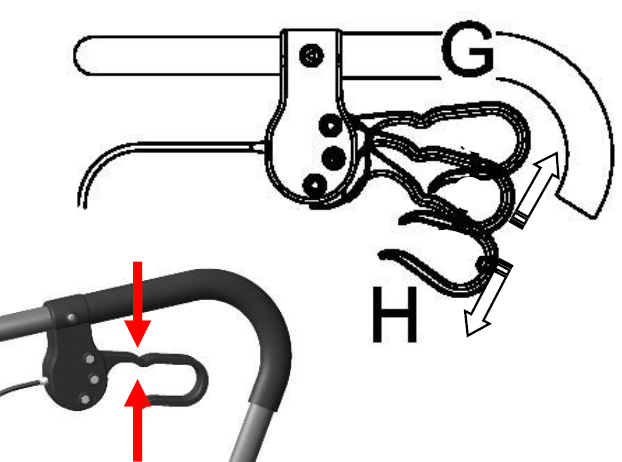
Folding the Rollator
UnfoldingPlace the Rollator down on its wheels and press the frame downwards. The folding lock mechanism (locking pins) must click fully into position.Folding upFlip the seat over and pull the red pull-cord with one hand until the locking mechanism is released. Using the other hand, lift the tube frame towards you.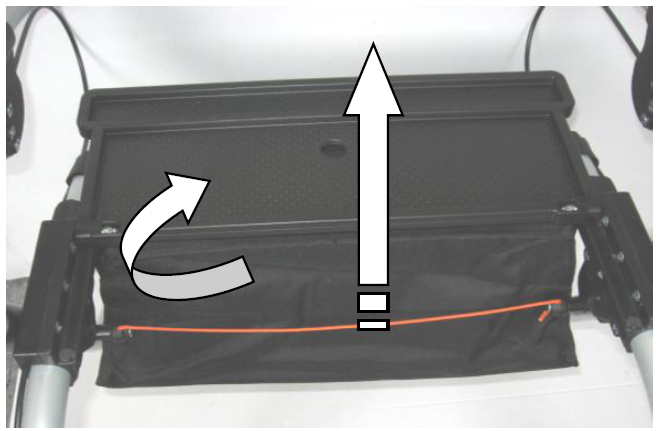
Adjusting and tightening the brakes
If the braking effect diminishes over time, then the Rollator may not be used and it must be repaired or adjusted by a qualified serviceman. It is decided whether an adjustment is enough, or if parts need to be replaced, by conducting a visual inspection.Loosen lock nut (X) and then adjust the brake with the adjustment screw (Y). Be sure that the released brake allows the wheel to turn unhindered, and that the wheel is locked when the brake is pulled. Then re-tighten the lock nut.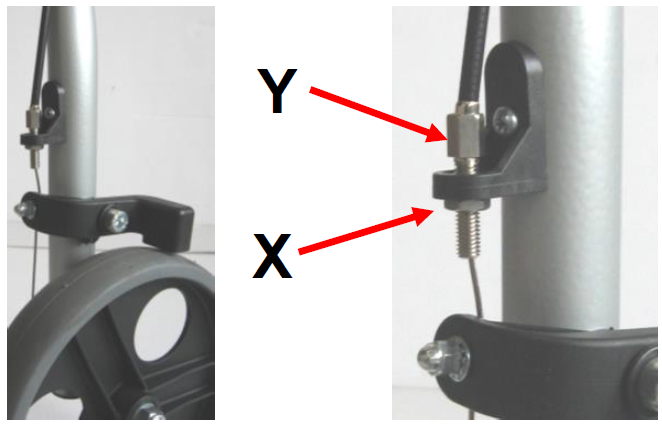
Trouble-shooting
| Fault | Possible cause | Correction |
| Wheels turn with difficulty |
Gummed up |
Clean, inspect regularly |
| Locking pins jam |
Gummed up |
Clean, Replace locking pins |
| No brake function |
Faulty |
Maintenance! Replace item |
| Reduced brake function | Generally defective, wear | Maintenance, Adjust brake |
| Wheels are bent | Impact against obstacles | Maintenance! Replace |
| Visible cracks or breakage |
Various causes |
Maintenance! Replace |
Care
In general the Rollator can be cleaned using a mild conventional cleaning and disinfecting agent. Then simply wipe the Rollator with clean water and cloth, and then wipe dry with a clean cloth.
Do not use an abrasive scouring agent or cleaner (read the product instructions!) that contain aggressive solvents (acids, thinners, etc.). Do not use stiff cleaning brushes, as these will damage the plastic surfaces or cause deposits to build up on the plastic parts and other materials.
Maintenance
The cause of accidents or damage may be due to the late detection of wear and / or improper use, as well as irregular maintenance.
For safety reasons and for preventing accidents, the Rollator must undergo a complete maintenance at least once a year. (Refer to the Medical Products Act and local requirements).Special requirements of the product arising from use by the patient may require more frequent maintenance intervals.
Maintenance / scope of inspectionMaintenance should include the following checks and be documented:Annex: Maintenance Report and Maintenance Overview.
- Visual check of all frame parts, such as: (damage, wear and corrosion)
- Rollator frame
- Grip handles
- Swivel castors
- Brake wheels
- Brake cable sets
- Hand levers with brake lever
- Plastic seat
- Back pad see: accessory
- Check all connector elements (screws, nuts) for completeness. Check fit and function.
- Check function of the folding mechanism.
- Function of the height adjustment.
- Function the brakes.
- Braking when rolling (rolling braking).
- Locking of the brakes (permanent locking)
If you have questions concerning maintenance and repairs to the Rollator, then contact an authorised dealer or medical equipment supply outlet.When making repairs, use only original spare parts from REBOTEC. Observe all advisories concerning guarantee and warranty.
Never make any unauthorised modifications or conversions to the Rollator. These will only adversely affect the safety and function of the Rollator.In such cases REBOTEC overtakes no liability!Follow all the instructions when ordering spare parts, re-use and product lifetime of the Rollator. After a complete maintenance or repair of the Rollator is done, we recommend a complete cleaning for assuring hygiene. Follow the cleaning instructions.
Technical specifications / equipment
Advisory!We reserve the right to make modifications and further developments with regards to the illustrated design and specifications contained in this User Instructions booklet at any time without the notice.
| Specifications | Polo-Plus-T/S | |
| Max. user weight | 120 | kg |
| Product weight | 7.4 | kg |
| Max. additional weight | 4.0 / bag content | kg |
| Length approx. | 700 | mm |
| Width approx. | 670 | mm |
| Seat width | 480 | mm |
| Seat height approx. | 490 | mm |
| Grip height approx.
5 stages / hole adjustm. approx. 20mm / hole) |
640 to 740 |
mm |
| Turning radius approx. | 950 | mm |
| Plain bearing wheels | D=200 | mm |
| Space needed (LxBxH) | 670x670x520 | mm |
| Specifications | Polo-Plus-T/M | |
| Max. user weight | 120 | kg |
| Product weight | 7,6 | kg |
| Max. additional weight | 4.0 / bag content | kg |
| Length approx. | 700 | mm |
| Width approx. | 670 | mm |
| Seat width | 480 | mm |
| Seat height approx. | 550 | mm |
| Grip height approx.
7 stages / hole adjustm. approx. 20mm / hole) |
690 to 820 |
mm |
| Turning radius approx. | 950 | mm |
| Space needed (LxBxH) | 750x670x520 | mm |
| Plain bearing wheels | D=200 | mm |
| Specifications | Polo-Plus-T/L | |
| Max. user weight | 120 | kg |
| Product weight | 7.8 | kg |
| Max. additional weight | 4.0 / bag content | kg |
| Length approx. | 700 | mm |
| Width approx. | 670 | mm |
| Seat width | 480 | mm |
| Seat height approx. | 600 | mm |
| Grip height approx.
10 stages / hole adjustm. approx. 20mm / hole) |
740 to 920 |
mm |
| Turning radius approx. | 950 | mm |
| Space needed (LxBxH) | 840x670x520 | mm |
| Plain bearing wheels | D=200 | mm |
For all models:
Angle between longitudinal center line of handgrip and movement direction: 0 degrees (parallel))
Accessory
Back pad/0,210 kg (Art. No.: 280.10.48) Suitable for models „M and „L“
Attention! Always put the shopping bag into the included bag fixed at the walker and do not attach it to the handle bar or put on the seat. Otherwise, there’s an increased danger of tipping over.
Back pad/0, 0060 kg (Art. No.: 280.10.48) Suitable for all modelsFor a more comfortable sitting (back support) a back cushion is offered. Fastening takes place using a zipper (A) on the handle bracket.
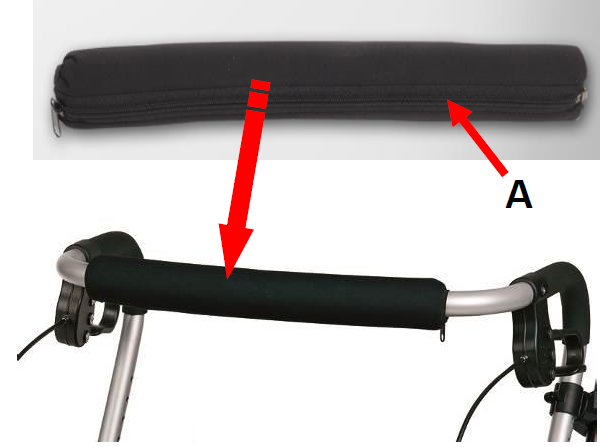
We also supply
- Walking aids
- Shoulder crutches
- Shower stools
- Shower and commode chairs Multifunction-W heel Chairs Rollators
- Patient lifting hoists Standing up aids

References
[xyz-ips snippet=”download-snippet”]


